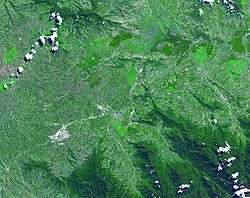Kuk Swamp
| Kuk Early Agricultural Site | |
|---|---|
| Name as inscribed on the World Heritage List | |
|
Satellite image of the wider Kuk Swamp area | |
| Type | Cultural |
| Criteria | iii, iv |
| Reference | 887 |
| UNESCO region | Asia-Pacific |
| Inscription history | |
| Inscription | 2008 (32nd Session) |
 Location of Kuk Swamp in Papua New Guinea. | |
Kuk Swamp is an archaeological site in New Guinea, that lies in the Wahgi Valley. It is the result of a former lake basin, filled by an alluvial fan or deposits of water-transported material. The Kuk creek must flow through the entirety of the fan to a catchment in the lower hills of the south region. Early channels that were created flowed this water past the reach of the fan. If these channels were to be blocked, as evidence suggests, it would turn into a swamp, diverting the water into smaller distributary channels. Evidence for early agricultural drainage systems was found here, beginning about 9,000 years ago. Features such as pits, postholes and runnels have been found at the site, which provide evidence for early agriculture. Such features are consistent with planting, digging and tethering of plants. Evidence has been found of irrigation draining ditches dating back to 9,000 years ago, with a number of plants including taro grown, at what would have been the edge of its cultivable limit in the highlands. These ditches can be divided into three types: major disposal channels, large field ditches, and small field ditches. The major disposal channels were built to divert water from the fan flowing south and direct them toward the northeast areas. The large and small field ditches are more uniform and surround the perimeter of the planting areas and then meet up with the major disposal channels. During this time, the people of Kuk Swamp transformed their landscape into an anthropogenic grassland suitable for agriculture.
During archaeological construction of the drainage channels artefacts were discovered including wooden digging sticks, a grindstone, and other small items. The ditches themselves were cleaned out and a small trench was dug to study the different layers of clay that have been used to construct the ditches. Different layers of clay used suggests and confirms different construction by previous people.
From 6,900 - 6,400 years ago further evidence has been found for the cultivation of bananas and sugar cane. Archaeologists have used archaeobotanical evidence to confirm the cultivation of bananas. Many banana phytoliths have been found in the cultivation plots of Kuk Swamp. Since bananas do not produce phytoliths in the same quantity and frequency as grass and other plants, researchers have been able to conclude that the abundance of banana phytoliths found in a managed grassed landscape between 6950 and 6550 years ago suggests deliberate planting.[1] The bananas grown at Kuk Swamp were Eumusa bananas, which stemmed the most significant and largest group of banana domesticates. This makes Kuk Swamp one of the earliest sites for the development of agriculture in the world.
In 2008, Kuk Swamp was listed as a World Heritage Site by UNESCO.
Notes
- ↑ Denham, T.P., S.G. Haberle, C. Lentfer, R. Fullagar, J. Field , M. Therin, N. Porch, and B. Winsborough. "Origins of Agriculture at Kuk Swamp in the Highlands of New Guinea." Science. 301.5630 (2003): 189-193. Web. 31 Oct. 2012. <http://www.sciencemag.org/content/301/5630/189.full>.
External links
- http://news.nationalgeographic.com/news/2003/06/0623_030623_kukagriculture.html
- http://whc.unesco.org/en/tentativelists/5059/
- http://www.sciencemag.org/content/301/5630/189.full
References
Bayliss-Smith, T. Golson, J. April 1992. A colocasian revolution in the New Guinea highlands? Insights from phase 4 at Kuk. Archaeology in Oceania. 27,1, pp. 1–22
Muke, J. Mandui, H. Oct 2003. In the shadows of Kuk: Evidence of prehistoric agriculture at Kana, Wahgi Valley, Papua New Guinea. Archaeology in Oceania. 38, 3, pp. 177–185
Coordinates: 5°47′1.36″S 144°19′54.2″E / 5.7837111°S 144.331722°E
Bayliss-Smith, T. Golson, J. April 1992. A colocasian revolution in the New Guinea highlands? Insights from phase 4 at Kuk. Archaeology in Oceania. 27,1, pp1–22
